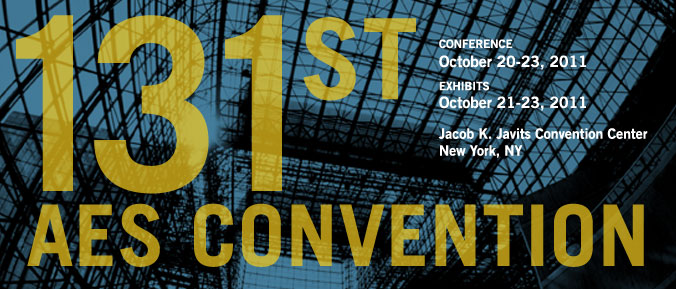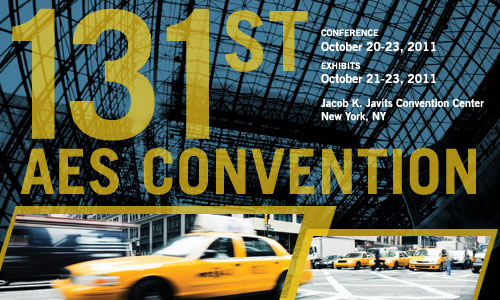
AES New York 2011
Paper Session P9
P9 - Applications in Audio
Friday, October 21, 9:00 am — 12:30 pm (Room: 1E07)
Chair:
Jonas Braasch, Rensselear Polytechnic Institute - Troy, NY, USA
P9-1 Simulation-Based Interface for Playing with Sounds in Media Applications—Insook Choi, City University of New York - Brooklyn, NY, USA; Robin Bargar, Columbia College Chicago - Chicago, IL, USA
Advanced audio processing for interactive media is in demand for a wide range of applications and devices. The requirements for interactive media contexts tend to impose both device-specific and style-specific constraints. The goal of the present research is to develop a robust approach to interactive audio that may be persistent across diverse media contexts. This project adopts a structural approach to the relationship of interactive sounds to interactive graphical media. We refer to this as a model-to-model architecture. Sound production is decoupled from specific media styles, enabling abstractions using feature analysis of simulation output that can be adapted to a variety of media devices. The identifying metaphor for this approach is playing with sounds through graphical representations and interactive scenarios.
Convention Paper 8491 (Purchase now)
P9-2 Advances in ENF Database Configuration for Forensic Authentication of Digital Media—Catalin Grigoras, Jeffrey M. Smith, Christopher W. Jenkins, University of Colorado Denver - Denver, CO, USA
When building an Electric Network Frequency (ENF) database for forensic purposes, ensuring that the recorded signal satisfies standards for forensic analysis is crucial. The ENF signal shall be free of clipping and lossy compression distortions, the signal to noise ratio shall be as high as possible, and the acquisition system clock shall be synchronized with an atomic clock. Using an ENF database to compare reference and questioned ENF involves precise measurements of amplitude, spectrum, and zero-crossings in order to accurately time-stamp, discover potential edits, and authenticate digital audio/video recordings. Due to the inherent differences in electronic components, building multiple ENF probes to create multiple databases with matching waveforms can be challenging. This paper addresses that challenge and offers a solution by using MathWorks MATLAB to calculate the best combination of components and produce graphical displays to help give a visual aid to the outcome in order to build a high quality ENF probe. This paper also addresses the challenge of establishing a fail-safe database to safely store the accurately acquired ENF information. This paper concludes that a reliable ENF database is mandatory for both scientific research and for forensic examination.
Convention Paper 8492 (Purchase now)
P9-3 Virtual Systems Engineering in Automotive Audio—Alfred J. Svobodnik, Harman International - Vienna, Austria
The present paper focuses on virtual product development for automotive audio systems. In the core a multidisciplinary simulation environment is used to perform all system engineering tasks in a fully virtual environment. First the theory of a multiphysical simulation model of electrodynamic loudspeakers is described. Subsequently, this model is extended to account for enclosures used as a resonance volume for loudspeakers (especially for reproduction of low frequency musical content). Furthermore, it is shown how the multiphysical model of loudspeakers and enclosures can be extended to simulate the radiation of sound waves into the car interior. Finally the virtual audio system, described by a multiphysical simulation model, is virtually tuned and auralized long before any piece of hardware exists. Tuning and auralization require that the simulation model is extended toward a multidisciplinary simulation environment as, additionally to engineering analysis methods, paradigms of the following disciplines are added: digital signal processing, psychoacoustics, binaural audio and subjective evaluation. The integration of the human factor (i.e., how audio events are perceived by humans with respect to spectral and spatial effects) is added in the tuning process and it is demonstrated how we can ultimately listen to a virtual audio system by means of advanced auralization techniques based on a binaural playback system. Additionally some remarks on the business benefits of these methods are given and uncertainties in our simulation models, which are inherent to every modeling approach, are addressed as well.
Convention Paper 8493 (Purchase now)
P9-4 Acoustical Modeling of Gunshots including Directional Information and Reflections—Robert Maher, Montana State University - Bozeman, MT, USA
Audio recordings of gunshots exhibit acoustical properties that depend upon the geometry and acoustical characteristics of nearby reflecting surfaces and the relative orientation of the firearm with respect to the recording microphone. Prior empirical studies have demonstrated the basic principles of gunshot recordings near the firearm and near the target. This paper describes an experiment to model the directional characteristics and reflections of several firearm types for a set of test configurations. The results show that reflections and reverberation can be a significant portion of the total acoustic energy received at the microphone.
Convention Paper 8494 (Purchase now)
P9-5 Influence of Recording Distance and Direction on the Analysis of Voice Formants—Initial Considerations—Eddy B. Brixen, EBB Consult - Smørum, Denmark; Siham Christensen
Based on recordings carried out in an anechoic chamber it is investigated to which degree the voice formants are affected by recording distance and direction in the near field (10, 20, 40, 80, and 100 cm) and different directions (on-axis, horizontally 45 and 90 degrees, vertically +/–45 degrees). This paper presents the analysis applied and discusses to what extent the results obtained must be taken into consideration when assessing voice samples for general phonetic research and for automatic voice ID/voice comparisons. It is concluded from the results of the analysis that especially weaker formants are displaced to a not negligible degree.
Convention Paper 8495 (Purchase now)
P9-6 Musical Movements—Gesture Based Audio Interfaces—Anthony Churnside, Chris Pike, Max Leonard, BBC R&D - Media City, Salford, UK
Recent developments have lead to the availability of consumer devices capable of recognizing certain human movements and gestures. This paper is a study of novel gesture-based audio interfaces. The authors present two prototypes for interacting with audio/visual experiences. The first allows a user to “conduct” a recording of an orchestral performance, controlling the tempo and dynamic. The paper describes the audio and visual capture of the orchestra and the design and construction of the audio-visual playback system. An analysis of this prototype, based on testing and feedback from a number of users, is also provided. The second prototype uses the gesture tracking algorithm to control a three-dimensional audio panner. This audio panner is tested and feedback from a number of professional engineers is analyzed.
Convention Paper 8496 (Purchase now)
P9-7 A Nimble Video Editor that Puts Audio First—Jörn Loviscach, Fachhochschule Bielefeld (University of Applied Sciences) - Bielefeld, Germany
Video editing software tends to be feature-laden, to respond sluggishly to user input—and to be focused on visuals rather than on auditory aspects. All of this is a burden when the task is to edit material in which audio plays the leading role, such as a talk show, a video podcast, or a lecture recording. This paper presents a highly visual no-frills video editor that is tailored to these tasks. It combines a range of techniques that speed up the process of searching and reviewing. They range from an overview-and-detail display to speech recognition to constant-pitch variable-speed playback. The implementation is heavily multithreaded and fully leverages the computer’s main memory to ensure a highly fluid interaction.
Convention Paper 8497 (Purchase now)
Information Last Updated: 20111005, mei

